Like our collection of trade goods, our canoes are essential tools for us. Where else can people see historic watercraft like these on the water? How else can we show the world what a voyageur brigade looks like? What better way is there to demonstrate the lives and work of the voyageurs?
From the time of their arrival in North America, European fur traders adopted the use of native watercraft for traveling through the wilderness. Native built bark canoes could carry heavy loads in shallow streams but were light enough to be hauled long distances over land. Built with stone tools from available materials, their design, size and appearance were varied to suit the many requirements of the fur trade.
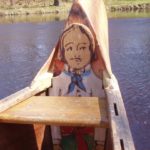
“Le petit homme,” head board decoration on our biggest north canoe.
Our reproduction canoes are based on these ancient designs. All are variations of the type known as north canoe. According to canoe authority Edwin Tappen Adney*, “of all birch -bark canoe forms, the most famous were the canots du maître or maître canots (also called north canoes, great canoes or rabeskas), of the great fur companies… In model, all the fur trade canoes had narrow bottoms, flaring topsides and sharp ends. The flaring sides were rather straight in section and the bottom nearly flat athwartships.”
As Adney further explains, “although no regulations appear to have been set by the fur companies to govern the size, model, construction or finish of these canoes, custom and the requirements of usage appear to have been satisfactory guides, having been established by practical experience. As a result, the length of canoes varied and the classification by “fathoms” or feet must be accepted as no more than approximate.
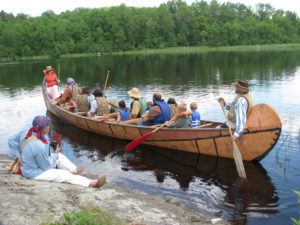
Giving big rides in the big canoe, Cloquet Rendezvous, July 2008.
Sometimes called ZeeBigCanot, our largest—and nameless—north canoe measures 30 feet overall. During the fur trade, a canoe of this size was used on larger rivers or Lake Superior.
It was built in the Twin Cities by members of the Minnesota Canoe Association as a Bicentennial project in 1975-76. The design was taken from a plan for a nineteenth century 5-fathom north canoe, like those built by Cree builders for the Hudson’s Bay Company. The plan was published in Adney’s definitive work “Bark Canoes and Skin Boats of North America.”
By 2004, the canoe had fallen into disrepair and was no longer usable. The MCA agreed to sell the canoe to us for $1. We undertook a major renovation, replacing the old fiberglass with a birch bark pattern; restoring its aerodynamic shape; and lowering the height of the ends to make the silhouette more correct. By careful force and stretching, I was able to give the canoe a new form which has made it more pleasant to paddle and easier to steer.
Only time will tell how long this canoe will continue as “she who shall remain nameless.”
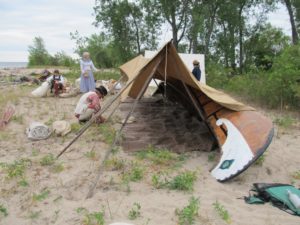
Shelter for the night under “Saint Pierre,” during our 2014 Lake-of-the-Woods canoe trip.
Our Saint Pierre was built in Chicago by Ralph Friese in 1974. It is a 26-foot north canoe, again based on Adney’s research, as interpreted by Friese. In the fur trade, a canoe of this size would have been used in larger rivers or along the shores of Lake Superior.
It is heavily-built, seats 8-10 and has seen hard service for many years. With four to six paddlers, we’ve used it on many of the major waterways of the Minnesota fur trade.
Both the big canoe and Saint Pierre are the most stable—we tend to use them with reluctant and inexperienced paddlers, provided we have skilled fore and aft paddlers with excellent skills at giving directions and getting people to do what is needed to be done. Saint Pierre is slower and harder to maneuver since it has more mass; surprisingly, the big 30-footer is really pretty maneuverable.
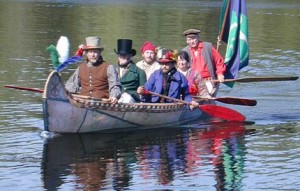
First voyage of “Amitie” on the Snake River during the 2003 Fall Gathering, North West Company Fur Post.
At about 21 feet long, Amitie is our smallest canoe. I designed her, adapting a plan by Adney for a 3-fathom rabeska, or smaller north canoe. Built by us in 2002-2003, we launched her onto the Snake River at Fall Gathering that year. I still have the mold in my shop. Every time I look at her, I think I’d like to build another one!
Amitie is constructed much like an actual birch bark canoe and it behaves like one. Responsive, fast and sensitive, she is safe (in the right hands) but feels tipsy.
This is our favorite canoe for two to four really experienced paddlers, or for adventuresome newbies under the direction of really good mentors. Highly maneuverable, this is our “sports car” model.
She really needs a ton of freight goods for stability. So unless we have some kind of freight aboard, we use large containers of water for weight. Canoes of this type are perfect for rocky waterways with frequent portages and cordelling, such as the Brule-St. Croix-Snake River run.
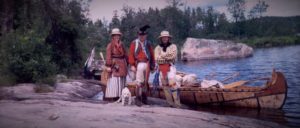
“Giwedinodin” with hearty paddlers JulieL, TomB, PatC and Tess the pup, on the Ely-to-Crane Lake leg of our 1992 BWCAW trip.
Giwedinodin (Ojibwe for “north wind”) is our 24-foot genuine birch bark canoe. Again, I designed this one from Adney plans. It was built by Mark Hansen of Grand Marais in 1988. The real thing! A delight to paddle! Well made, easy on the portage, she was a lively and fine vessel to travel in.
But back then we had not heard of climate change. The birches of northeastern Minnesota were already affected by insects and disease. As a result, the bark was perforated with multitudes of minute pin pricks that constantly let water seep in. Constant bailing was inevitable. We had about a decade of use before selling it to the Minnesota Historical Society to become the centerpiece of the new visitor center exhibit at North West Company Fur Post in Pine City.
By paddling and displaying these canoes, La Compagnie has found that they really help us bring the fur trade to life for our visitors. Come out and join us on the water. Paddle any of our canoes . . . you’ll be glad you did!!
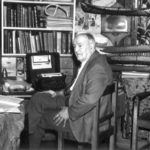
Edwin Tappen Adney, in his office, from a “Time” magazine story, 1939.
* Edwin Tappan Adney (1868-1950) was an artist, writer, ethnographer, historian and model maker of unparalleled ability. He devoted his life to studying the cultures and languages of native cultures, particularly their watercraft. His research was assembled into “Bark Canoes and Skin Boats of North America” (Skyhorse Publishing; reprint edition, 2014). This definitive work, illustrated with line drawings, diagrams and photos, combines historical background with easy-to-understand, practical instructions.

